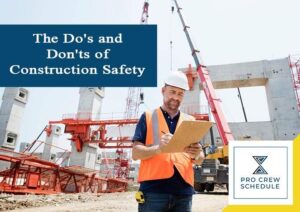The construction site is known to be one of the most dangerous workplaces globally but somehow the most overlooked. More than the unprecedented number of injuries and happens that occur on-site, these circumstances have the potential to be life-threatening to the people involved. As a construction professional who has a part in managing construction projects, chances are you will be mandated to make frequent site visits and inspections, sometimes with little notice. This is enough reason for people in construction to be more vigilant than any other profession.
According to the NSW News, approximately 25,000 laborers were injured in the construction jobsite in Australia due to unsafe practices, and that’s only in the past three years. Among these, 1700 workers were permanently disabled, and 23 people lost their lives. These are undoubtedly alarming and make the construction less and less appealing. However, even as these statistics grow, the demand for new structures and projects never seems to decrease.
To help you avoid the unfortunate hazards that might happen on-site, we’ll dive into the do’s and don’ts in construction to reduce workplace accidents and to ensure your safety, and even more, the lives of your team. With these guidelines strictly implemented and continuously followed, construction will stop being a scary place.
What To Do and Not to Do at Construction Sites
DO educate your workers about the hazard of construction sites.
The construction site is full of a wide array of potential hazards. Some of the most common dangers in the construction site include the following:
- fall from high areas;
- falling objects;
- exposure to toxic substances;
- carrying heavy materials and loads;
- inhalation of dust;
- machinery accidents; and
- working in confined spaces.
Before any worker – regardless of his/her role or experience level – can set foot at any construction job site, he/she must be adequately informed and aware of the possible hazards that can occur on-site. Ignorant and semi-skilled laborers can perhaps be the biggest dangers in any business, as their unknowing can unconsciously put everyone around them at risk. Fully understanding the perils at hand and being in a perpetual state of alertness is perhaps the best way to prevent injuries or accidents.
DO follow the most frequently cited standards in construction by Occupational Safety and Health Administration (OSHA).
To further educate yourself and your team regarding the construction risks and how to avoid them, you must be aware of the standards that are stated as follows:
- Scaffolding: fall hazards have a high chance of occurring when scaffolds are not used properly.
- Fall Protection: incorporate aerial lifts on-site to provide safer working surfaces for the elevated platforms on site.
- Excavations: never allow anyone to enter unprotected trenches.
- Ladders: avoid ladders containing metallic components near power lines and areas with on-going electrical works.
- Head Protection: use body harnesses and safety net systems.
- Excavations: use protective systems for trenching works that are 1 foot deep or greater.
- Hazard communication: make information accessible and easy to understand so all workers would be able to understand it. Use language and comprehensive formats.
- Fall Protection: adapt an effective construction workers safety training program for hazardous tools and substances that might be present on site.
- Personal Protective Equipment: construction workers should wear work equipment made specifically for job sites, such as work boots that are slip-resistant or puncture-resistant soles.
- Electrical Protection: regularly check all equipment and electrical tools for any defect or low voltage wiring.
DO hire the right people who will supervise and manage the activities and the construction site workers.
Ideally, construction workers should understand and ramify how dangerous a construction site is and thus act to guarantee site-wide well-being- but this never materializes in a real-life setting. In line with this, every construction site must have a Safety Officer or a strong supervisor who is willing and capable of enforcing the safety regulations without any exception.
On the other hand, a foreman must keep a documented tabs on all construction workers throughout the day and correct those who do not implement proper safety procedures.
DO provide Proper Protective Equipment to your team.
To create a culture focused on construction safety, you need to give your workers the right set of equipment and adequate workspace for the job at hand. Without the proper equipment, construction site safety can’t happen because there will always be a chance of getting injuries when using the wrong equipment. Construction workers equipped with incorrect gear are bound to make severe or even fatal errors. Not only should every piece of equipment on the job site be suited for every single task or job at hand, but construction companies must ensure that all machinery and tools are well maintained.
Apart from the PPEs that should be supplied, the simplest and most essential things are often overlooked. Some of these examples are an abundant supply of water and shady areas in order to prevent dehydration and exposure-to-the sun-related illnesses. Another helpful tool that can be added is fabric structures where workers can store equipment and cover incomplete and dangerous areas on site. Small changes, they may seem, but they sure can save a life.
DON’T forget to document every movement on the construction jobsite.
To vigorously enforce construction site safety, you have to ensure that you and your team have a proper documentation system of everything that is happening or happen on-site. There are some legal requirements most contractors have to provide for any project to begin, and all needed licenses and registrations must be secured before any project can commence.
Subcontractors who will be charged with dangerous construction activity, such as blasting, certainly should provide a supporting certification well in advance of their deployment to the jobsite. Not only will this prevent accidents from taking place, but it will also protect construction companies from public scrutiny and legal actions. Ant kind of safety hazard that will make its way on social media will indeed look bad for any business.
No construction worker would want to work for a company that doesn’t put its worker’s safety as an utmost priority. Implementing safety measures on construction sites will prevent possible accidents from happening in the first place. Also, documenting all the field activities using cloud project management software like ProCrew Schedule makes it easier than ever before to prevent future accidents or lawsuits from happening.
DON’T stick to the traditional practices and refuse learning opportunities.
Even though most construction worker’s skills can be adapted from the jobsite, safety is one skill that is best learned before stepping into any job site. Experienced workers are expected to further their knowledge on construction standards on safety by attending regular training sessions at least once a year. Their training sessions will go over the simplest to the most life-saving practices such as fall protection and the proper use of a ladder, but the main goal to ensure that everyone is adequately trained. After these training sessions, the workers should know what safety measures must be implemented in case of an incident.
Even though training sessions are conducted all year round, applying and practicing safety training skills on the job site would help construction workers enforce safety regulations effectively. Without proper training, workers can be easily injured or killed. In environments where accidents and fatalities are highly likely, essential safety training is necessary and will prevent unfortunate circumstances that will hurt you ethically and economically.
DON’T fall on deaf ears on your workers.
Accidents are likely to happen when workers are uncertain of what to expect at work. Direct discussion of the day’s activities and goals will prevent surprises that could cause bodily harm to the workers. Contractors would be wise to equip their staff with devices like smartphones, headsets, and walkie-talkies, allowing faster and more efficient communication between the team. Clear communication with everyone expedites the project and helps each of the workers remain informed and on track with the project’s progress.
Key Takeaways
One of the construction industry’s ultimate goals is to reduce workplace injuries, accidents, and deaths to zero. The fewer the accidents are, the more popular and appealing the sector will be. Not only is construction essential to avoid injuries, but there are also plenty of various long-term benefits that your construction business is about to gain. By implementing the safety procedures that will promote a healthy environment, your employees are much more likely to be happier and satisfied with their roles.
Suppose your workers possess the right tools and knowledge. In that case, it can dramatically boost morale in the construction site and produce more productive working hours, eventually leading to better profitability. You can also establish a good reputation for your construction business in the long term, helping to retain workers.
There is no standard way to decrease these alarming accident statistics to zero, but following the simple tips discussed above to help promote construction site safety will pave the way to get there.
Want to learn more on how to improve the management of your construction projects? Subscribe to our newsletter here to get the latest news and contents first and for free. You don’t want to miss this.







